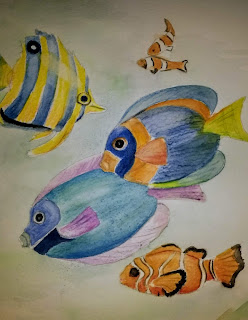WATERCOLOR PENCIL TECHNIQUES
Today's lesson was about some water color techniques. Here are some web sites/youtubes
that can help refresh your memory:
Mr. Otter Studio 4 WC pencil techniques
Bob Davies mallard duck
Frugal Crafter – Daffodil
Julie Davis, Cheap Joe’s--a time lapse
The name of the book I showed pictures from is Water-Soluble Colored Pencils by Gary Greene. (Northlight Books 1999)
Square 1: color some pencil on the top of the square. Wet it and create a graded wash. When that is dry, try lifting some of it with a stiff brush.
Square 2: Apply dry pencil on the top, and another on the bottom. Wet the colors and blend ink the center. When dry (you can use a blow dryer), GLAZE a third color over it to show that you can create a beautiful glaze.
Square 3: Practice dry strokes: cross hatching, small circles, stipling, etc.
Square 4:Wet the paper. Use sandpaper on a dry pencil to create texture on the square.
Square 5: Sandpaper some dry pencil on a wet square. Then, using a flat brush, drag the brush across the shavings to create an effect that looks like birch tree bark.
Square 6: With a damp round brush pull some color off a pencil. At the top, paint color with it.
Wet the bottom of the square, and pull color off a pencil. Paint wet into wet.
Square 7: With a damp FLAT brush, load color from one color on one side of the brush, and another color on the other side of the brush. Paint a stroke, like a rainbow, on dry paper. Then try it on wet paper.
Square 8: Create a "Palette" of colors. Just apply dry pencil in a circle, over and over, until you have a thick layer of pencil on the paper. Use several colors. Wet a brush, dip into a color on the palette, and paint as you would regular paint. (In last square)
Square 9: Wet the paper. Draw directly onto the wet paper with pencil. It creates very dark color.
Square 10 and 11: Color a few areas of pencil. Spray with water and let it drip.
Square 12: Paint in from your palette in square 8.

The above picture uses at least five different methods. (1) The background is wet, then color is pulled off a blue and green pencil and applied wet into wet. (2) The blue and purple fish is colored by coloring dry pencil onto dry paper. I have used several colors together before wetting to blend. (3) While the blue fish is wet, I SANDED to create some texture. (4) One the blue and orange fish, I wet the paper, then used two blue pencils to create squiggly lines across left to right. Then I wet over it again to blend a little. (5) I LIFTED hilights on the top of the yellow fish and orange clown fish.
WHY WATERCOLOR PENCILS?
1.
They are easy to travel with.
2.
Easy to get smaller details.
3.
Can be used dry like colored pencil or
moistened to look like watercolor.
4.
Can make corrections to over-worked paper.
5.
They can be subtle or vibrant.
6.
Use with yupo paper when paint won’t stay
7.
Can draw with them first, then paint over.
8.
Can use in sketch book, and come back a month later
to paint
9.
CONTROL over paint
10.
Less likely to accidentally spatter
11.
Paper usually gets less wet.
12.
Can be used in combination with water color, colored pencil, or
by itself
13.
Adjacent areas can be painted sooner bc they dry
faster
14.
Very little mess, clean-up
15. Great with kids!
SOME TIPS
1.
Wet from white or light to the darkest to avoid
losing whites
2.
Don’t over use the water.
3.
I try to use two or three colors together for
more natural color.
4.
Use water color paper
WHAT BRANDS SHOULD I BUY?
You might watch Steve Mitchell's youtube on watercolor pencils. He favors


